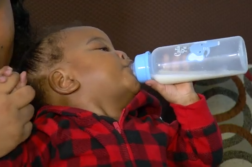SAN FRANCISCO. (Ivanhoe Newswire) — Progress on a new artificial kidney has been so promising the FDA has fast-tracked its development. That’s potentially life-saving news for the 100,000 people the National Kidney Foundation says are on a waiting list for a transplant right now. Only 20,000 kidneys will be available for them this year.
David Anderson has walked into a dialysis clinic 2,300 times since 1999. He comes four times a week for hours, while a machine does what his kidneys should: remove toxins from his blood.
“It’s a very time-consuming experience and when my treatment today is finished, I’m going to be tired. Not a whole lot will get done tonight,” detailed Anderson.
Shuvo Roy, a bioengineering professor at UC San Francisco, told Ivanhoe, “Over the course of the last few years, we’ve advanced the membrane technology, we’ve developed cell engineering, and currently, we are in animal testing.”
Roy is developing an implantable bio artificial kidney.
It would go in the same place as a donor kidney. Anderson’s doctor, Lynda Frassetto, M.D., a professor of Medicine at UC San Francisco, said the need is critical.
“This would allow us to build kidneys and then we could just put them in to people. Really, it would just be a totally astounding thing for us to be able to do that,” said Dr. Frassetto.
Anderson agrees.
“I would participate in trials or get an artificial kidney this evening if that were available,” Anderson told Ivanhoe.
The government estimates kidney failure costs Medicare more than $30 billion a year and takes up eight to nine percent of its budget. Anderson’s treatment alone is close to three and a half million. Professor Roy and Dr. Frassetto said any investment in artificial kidney technology will eventually save money and lives.
Contributors to this news report include: Cyndy McGrath, Supervising Producer; Wendy Chioji, Field Producer; Milvionne Chery, Assistant Producer; Brent Sucher, Editor; Rusty Reed, Videographer.
MEDICAL BREAKTHROUGHS – RESEARCH SUMMARY
TOPIC: Building an Artificial Kidney: Medicine’s Next Big Thing?
REPORT: MB #4160
BACKGROUND: A kidney transplant is a surgery in which a person with kidney failure receives a new kidney. When a person’s kidneys fail, they have two options: dialysis or transplant. A successful kidney transplant typically provides a better quality of life because it may mean more energy and a less strict diet. There are currently 100,000 people on the transplant waiting list for a new kidney. However, there are only 20,000 kidneys available for transplant this year.
(Source: https://www.kidney.org/atoz/content/kidneytransnewlease)
DIALYSIS: Dialysis does some of the things done by healthy kidneys. It is needed when a person’s own kidneys can no longer take care of their body’s needs. Usually when someone loses about 85 to 90 percent of their kidney function, they are in kidney failure and need dialysis. Dialysis now costs about $90,000 per year per person. Dialysis works by removing waste, salt and extra water to prevent them from building up in the body. It also helps to keep a safe level of certain chemicals in the blood, such as potassium, sodium and bicarbonate. Some kinds of acute kidney failure get better after dialysis treatment so dialysis may only be needed for a short time. In chronic or end stage kidney failure, kidneys do not get better and dialysis will be needed for the rest of a person’s life. A doctor may then determine whether that person is a candidate for a kidney transplant and place them on the waiting list. Only about one in three patients who begin dialysis survive longer as compared to four in five transplant recipients.
(Source: https://www.kidney.org/atoz/content/dialysisinfo)
NEW TECHNOLOGY: An implantable bio artificial kidney is being developed by Shuvo Roy, a bioengineering professor at University of California, San Francisco. This artificial kidney, which is a year away from human trials would replace the need for a kidney transplant. It would go in the same location as a donor kidney and perform same functions as a regular kidney: remove toxins from the blood.
(Source: Shuvo Roy, PhD)
FOR MORE INFORMATION ON THIS REPORT, PLEASE CONTACT:
Nick Weiler
415-476-8255
If this story or any other Ivanhoe story has impacted your life or prompted you or someone you know to seek or change treatments, please let us know by contacting Marjorie Bekaert Thomas at mthomas@ivanhoe.com




